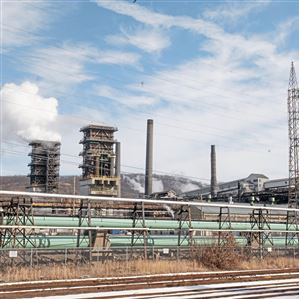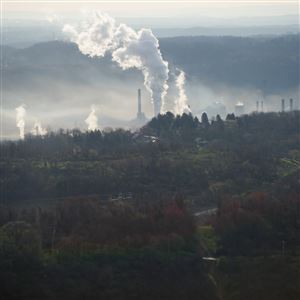The air in the Monongahela River Valley was putrid enough this week that Fawn Walker Montgomery felt as if she had to get a new inhaler.
“When the air quality alert comes in, it smells worse, the coughing starts — all kinds of stuff,” she said Thursday.
Since last week, residents throughout the Pittsburgh region have taken to social media, crowdsourcing networks and other outlets commenting on the smell of rotten eggs, caused by hydrogen sulfide in the air. The Allegheny County Health Department’s records show that at its Liberty monitor, the average and maximum levels of hydrogen sulfide, a colorless gas, rose above the state standard of 0.005 parts per million on each of the last six days.
Levels were high enough to trigger an alert from the Allegheny County Health Department last Friday. While the levels dropped Saturday, they went back up again. And the Pennsylvania Department of Environmental Protection on Tuesday declared a Code Orange Air Quality Action Day for a different measure, fine particulate matter, in the Liberty-Clairton area.
Ms. Walker Montgomery, the CEO and founder of Take Action Advocacy Group (formerly known as Take Action Mon Valley), was even issuing warnings about it to the canvassers doing voter outreach with her.
“It’s not even really the rain” that they’re watching out for, she said during a downpour Thursday. ”It’s the air quality.”
Hydrogen sulfide occurs naturally, but it is also produced by industrial sources, according to the Agency for Toxic Substances and Disease Registry, a federal public health agency. Exposure to low levels of the gas over a long term can cause eye irritation, headaches and fatigue, while breathing it in at high levels can be deadly after just a few breaths.
Some advocacy groups have been raising the alarm over the past 10 days. The Group Against Smog and Pollution on Friday criticized government agencies for their “barebones public alerts.”
“People continue to suffer, and every day they don’t hear from [the] Allegheny County Health Department, the more public trust is eroded,” GASP Executive Director Patrick Campbell wrote in a statement. “We’ve said it before and it bears repeating now: This has been a failure of leadership and residents deserve better.”
The ACHD Bureau of Environmental Health’s deputy director, Geoffrey Rabinowitz, wrote in an email that the department has a team continually monitoring pollutant and meteorological data related to air quality. He said they have also seen the many comments related to hydrogen sulfide, and they continue to conduct research.
He also noted that the department monitors previously conducted a study on hydrogen sulfide in the Mon Valley, and said his team continues to conduct similar research.
That report, released in March, used data from January 2020 to March 2022 to determine that emissions from the U.S. Steel coke processing facility in Clairton were responsible for the high levels of the gas.
According to the report, there were 153 days since 2020 when hydrogen sulfide levels at a county air monitoring site exceeded state air quality standards. The company was fined $1.8 million for exceeding limitations on hydrogen sulfide.
“There are many factors that contribute to poor air quality,” Mr. Rabinowitz wrote in an email Friday. “Industrial sources of air pollution can contribute to high readings at regulatory monitors. Weather can increase and decrease the ability of pollutants to disperse, making it more noticeable to the general public, but weather is generally not a reason for high readings.”
An inversion — a layer in the atmosphere in which the temperature gets warmer, rather than cooler, as elevation increases — can sometimes affect air quality because it traps cool air closer to the ground, causing pollution to accumulate. Typically, they happen at night and break during the day.
The effects of inversion and the emissions from industrial sites such as U.S. Steel’s Clairton plant must both be taken into account when considering why hydrogen sulfide has been so prevalent recently, according to Albert Presto, a research professor with Carnegie Mellon University’s Center for Atmospheric Particle Studies.
“You need the emissions part of it,” he said. “It’s not like the inversion is the only thing creating high concentrations.”
GASP asserted in its Friday morning statement that the hydrogen sulfide concentration at the ACHD’s monitor in Liberty has surpassed the state’s 24-hour standard for much of the past week, but the health department has not announced that.
A U.S. Steel spokesperson, when reached for comment, said the company “is aware that ACHD issued air quality alerts regarding the hydrogen sulfide readings recorded at the Liberty Monitor. As we have reported to ACHD, there were no abnormal operations or issues at the Clairton Plant.”
The ACHD suggested residents check the agency’s daily dispersion report when there is a morning inversion to see when it will break.
On days when fine particulate matter is higher than EPA standards, the ACHD said children, seniors and those with lung and heart conditions should reduce prolonged outdoor activities.
First Published: October 15, 2022, 10:00 a.m.



















